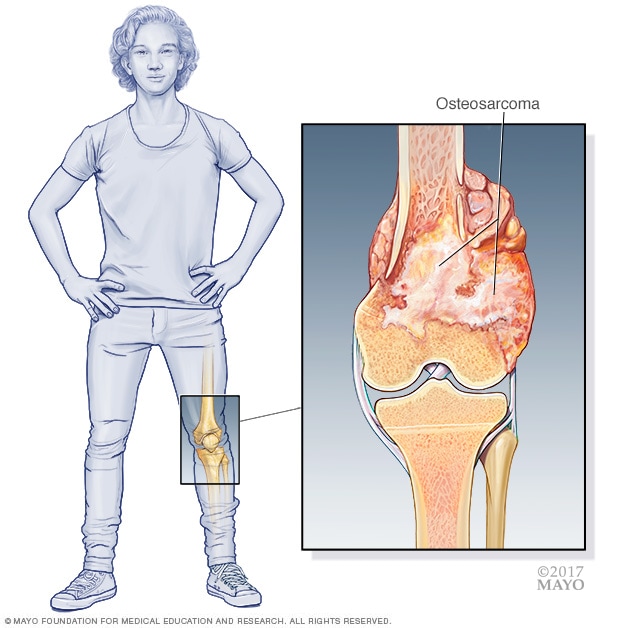Overview
Osteosarcoma

Osteosarcoma
Osteosarcoma is a kind of bone cancer. It most often starts in the long bones of the legs or the arms. But it can happen in any bone.
Osteosarcoma is a kind of cancer that begins in the cells that form bones. Osteosarcoma tends to happen most often in teenagers and young adults. But it also can happen in younger children and older adults.
Osteosarcoma can start in any bone. It's most often found in the long bones of the legs, and sometimes the arms. Very rarely, it happens in soft tissue outside the bone.
Advances in the treatment of osteosarcoma have improved the outlook for this cancer. After treatment for osteosarcoma, people sometimes face late effects from the strong treatments used to control the cancer. Healthcare professionals often suggest lifelong monitoring for side effects after treatment.
Products & Services
Symptoms
Osteosarcoma signs and symptoms most often start in a bone. The cancer most often affects the long bones of the legs, and sometimes the arms. The most common symptoms include:
- Bone or joint pain. Pain might come and go at first. It can be mistaken for growing pains.
- Pain related to a bone that breaks for no clear reason.
- Swelling near a bone.
When to see a doctor
Make an appointment with a healthcare professional if you or your child has ongoing symptoms that worry you. Osteosarcoma symptoms are like those of many more common conditions, such as sports injuries. The health professional might check for those causes first.
Causes
It's not clear what causes osteosarcoma.
Osteosarcoma happens when bone cells develop changes in their DNA. A cell's DNA holds the instructions, called genes, that tell a cell what to do. In healthy cells, the DNA gives instructions to grow and multiply at a set rate. The instructions tell the cells to die at a set time.
In cancer cells, the DNA changes give different instructions. The changes tell the cancer cells to make many more cells quickly. Cancer cells can keep living when healthy cells would die. This causes too many cells.
The cancer cells might form a mass called a tumor. The tumor can grow to invade and destroy healthy body tissue. In time, cancer cells can break away and spread to other parts of the body. When cancer spreads, it's called metastatic cancer.
Risk factors
Most people with osteosarcoma don't have any known risk factors for the cancer. But these factors can increase the risk of osteosarcoma:
- Certain conditions that run in families. These include hereditary retinoblastoma, Bloom syndrome, Li-Fraumeni syndrome, Rothmund-Thomson syndrome and Werner syndrome.
- Other bone conditions. These include Paget's disease of bone and fibrous dysplasia.
- Prior treatment with radiation therapy or chemotherapy.
There is no way to prevent osteosarcoma.
Complications
Complications of osteosarcoma and its treatment include the following.
Cancer that spreads, also called metastasizes
Osteosarcoma can spread from where it started to other areas. This makes treatment and recovery harder. Osteosarcoma most often spreads to the lungs, the same bone or another bone.
Coping after surgery to remove an arm or leg
Surgeons aim to remove the cancer and spare the arm or leg when they can. But sometimes surgeons need to remove part of the affected limb to remove all the cancer. Learning to use an artificial limb, called a prosthesis, takes time, practice and patience. Experts can help.
Long-term treatment side effects
The strong treatments needed to control osteosarcoma can cause major side effects, both in the short and long term. Your healthcare team can help you or your child manage the side effects that happen during treatment. The team also can give you a list of side effects to watch for in the years after treatment.
Dec. 22, 2023